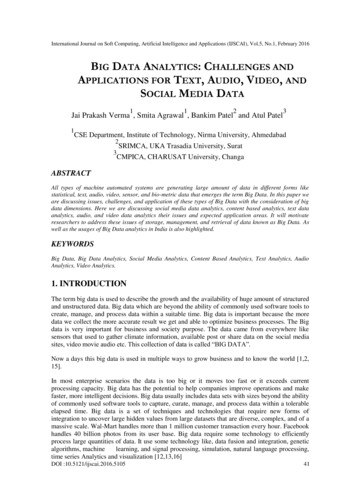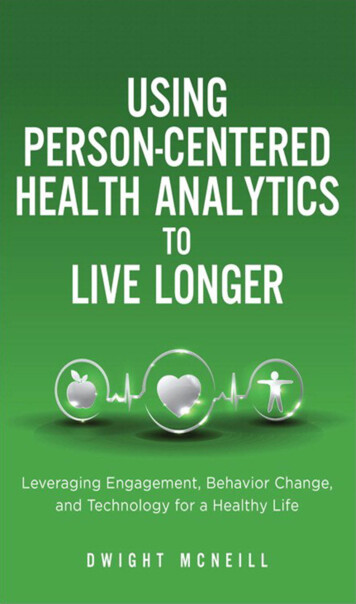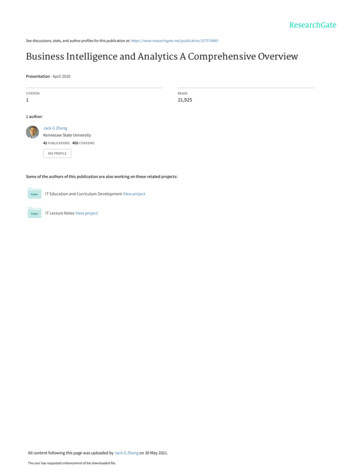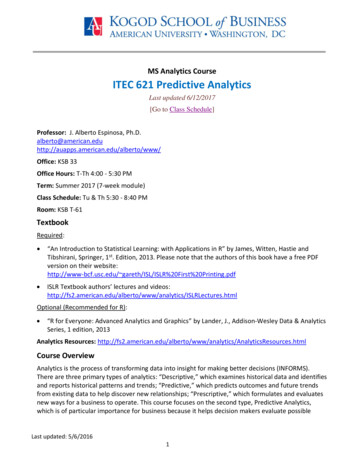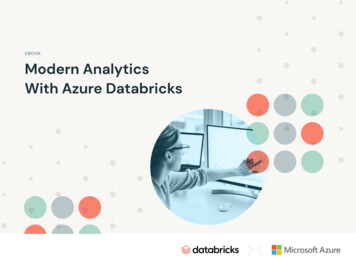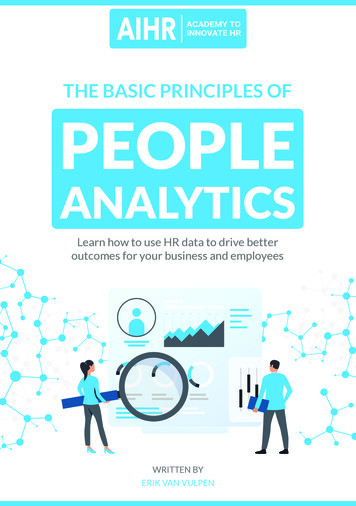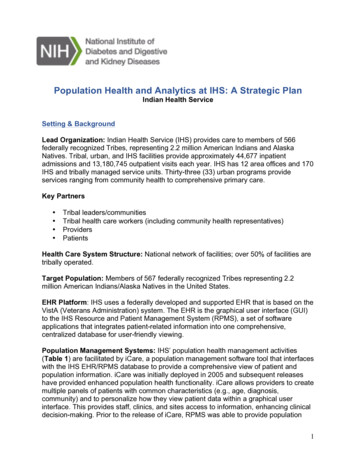
Transcription
Population Health and Analytics at IHS: A Strategic PlanIndian Health ServiceSetting & BackgroundLead Organization: Indian Health Service (IHS) provides care to members of 566federally recognized Tribes, representing 2.2 million American Indians and AlaskaNatives. Tribal, urban, and IHS facilities provide approximately 44,677 inpatientadmissions and 13,180,745 outpatient visits each year. IHS has 12 area offices and 170IHS and tribally managed service units. Thirty-three (33) urban programs provideservices ranging from community health to comprehensive primary care.Key Partners Tribal leaders/communitiesTribal health care workers (including community health representatives)ProvidersPatientsHealth Care System Structure: National network of facilities; over 50% of facilities aretribally operated.Target Population: Members of 567 federally recognized Tribes representing 2.2million American Indians/Alaska Natives in the United States.EHR Platform: IHS uses a federally developed and supported EHR that is based on theVistA (Veterans Administration) system. The EHR is the graphical user interface (GUI)to the IHS Resource and Patient Management System (RPMS), a set of softwareapplications that integrates patient-related information into one comprehensive,centralized database for user-friendly viewing.Population Management Systems: IHS’ population health management activities(Table 1) are facilitated by iCare, a population management software tool that interfaceswith the IHS EHR/RPMS database to provide a comprehensive view of patient andpopulation information. iCare was initially deployed in 2005 and subsequent releaseshave provided enhanced population health functionality. iCare allows providers to createmultiple panels of patients with common characteristics (e.g., age, diagnosis,community) and to personalize how they view patient data within a graphical userinterface. This provides staff, clinics, and sites access to information, enhancing clinicaldecision-making. Prior to the release of iCare, RPMS was able to provide population1
health functionality through a query tool, but this functionality was not intuitive for theend user. For additional detail, see RPMS iCare (BQI v2.1) from the IHS website.iCare's interface consolidates patient information from various software applications andcomponents of the RPMS database under a single interface.Time Period IHS was an early adopter of EHRs with a health information technology (HIT)system in place since 1987 and an ongoing commitment to open sourcemeaningful use (MU)-certified HIT systems. By July 2015, the RPMS EHR was inuse at 459 of 470 facilities (98%). IHS has developed a population health management strategic plan (2015 –2020).Contact for Additional Details: CIO@IHS.govIntroductionIHS strives to provide comprehensive services to a very high-risk population. To thisend, IHS implemented the patient-centered medical home (PCMH) model in the 1980s,and tracks outcomes at both the community/population and patient level. The followingare key elements of the PCMH approach: Population health management (includes defined panel lists, reminders, use ofdisease/condition-specific registries/populations, diagnostic tags, use ofdemographic information, longitudinal tracking);End user (including tribal community member) involvement in development ofrequirements;Performance measurement; andQuality improvement.Given limited resources, IHS has relied heavily on technology— the RPMS system andthe EHR in particular. To guide HIT activities and ensure that key goals and objectivesare met, IHS developed a 5-year strategic plan starting in 2004, with 5-year updates(Box 1). The most recent plan, Vision 2020, is for 2015-2020. HIT and the ability toacquire, consume, and report data are viewed as key quality improvement tools.An important aspect of this work has been involving the community— tribal communityleaders as well as tribal health boards. IHS is committed to having effective partnershipsand collaborations at the community level, using activities such as local listeningsessions to help facilitate a two-way flow of information. In response to requests fromthe community, IHS ensures data are made available to communities in accessible andeasy-to-understand formats, allowing communities to use the data to make decisionsabout local health priorities. IHS also drives clinical quality measures based on triballyidentified health priorities as well as external reporting requirements.2
Table 1: IHS HIT and Population Management SystemsSystemSupport TasksRPMSiCare Manage the care of patients and patient populations. Access a comprehensive view of patient informationwhen used in combination with the EHR. Create multiple panels of patients with commoncharacteristics (e.g., age, diagnosis, community). Create custom patient panels. Enable provider review. Population, community, and patient views of data allowdisplay of clinical quality measures from patient,population (registry), and/or provider perspective. Relies on national taxonomy standards that areendorsed and integrated into RPMS and the Cache dB. Enable the collection and reporting of clinicalperformance results provided annually to HHS and toCongress. Access on demand clinical performance measuresfrom the local RPMS database with nighttime updatesfor the health care team as well as other local users,including tribal leaders. Generated printed or electronic report for any or all ofover 300 clinical performance measures, representing74 clinical topics (Healthcare Effectiveness Data andInformation Set [HEDIS]/National Committee for QualityAssurance [NCQA], The Joint Commission). Update clinical performance measure logic anddefinitions annually. Use of taxonomies to ensure comparable query resultsacross facilities. Access reports that are required by statute andregulation. Generate Government Performance Results Act(GPRA) reports. Access a broad range of clinical and administrativeinformation to enable better management of individualpatients, local facilities, and regional and nationalprograms. Access historical repository of patient registration andencounter information dating back to October 2000. Access highly focused, often temporary, program datamarts to support searches and reports on a subset arehouse(NDW)User Segments withAppropriatePermission/Security Local providers andnursing staff/appropriatehealth care teammembers Local population healthspecialists Local schedulers Local health careadministrators Local case managerstribal administrators Office of Public HealthSupport (OPHS)/Divisionof Planning, Evaluationand Research(DPER) Local providers Local health careadministrators Managers at all levels ofIHS National and areaheadquarters programstaff Statisticians Epidemiologists Population healthspecialists Senior leadership OPHS/Division ofProgram Statistics (DPS) National and area GPRAcoordinators3
Box 1: Strategic Plan Goals (2020) Increase consumer empowerment and person-centered care.Improve the sharing and use of patient-generated health data.Connect an expanded set of users and data sources through the use oftelehealth, mobile health, and wearables.Improve systems to support chronic disease management and selfmanagement support.Health care teams will have on demand access to the information they need inan easy to consume and useful manner; technology and data will not be abarrier during the patient encounter.Improve capability to support population health management through theapplication of data analytics.MethodsThe strategic plan is designed to meet the needs of key IHS stakeholders (Table 2).Details of Population Health Management InterventionAccess to data provides clinicians opportunities to improve care at the patient andcommunity level. The current system includes a query tool that allows clinicians tosearch their patient base at the point of care using Boolean logic in a graphic userinterface, both facilitating ease of use and increasing use.This allows clinicians (as well as the many medical students and other trainees thatrotate through IHS facilities) to engage in quality improvement activities. For example, ifclinicians notice a health-related trend in their patients, they can conduct longitudinaland community-based queries related to this condition in order to explore it in greaterdetail at the community- and patient-level.Summary of Health Care System Changes and ModificationsThe process has been incremental, built on the implementation of the HIT system sincethe 1980s. Implementing changes over time has reduced the burden on clinicians, andhas supported the PCMH model through increased ease of use and the ability to quicklyevaluate impact of interventions to improve care.4
Table 2: Expected Vision 2020 Outcomes for StakeholdersStakeholder Group Expected OutcomesConsumers/Patients Will be the focus point of our processes, will experience anintegrated, culturally sensitive, seamless health careencounter with limited wait times, no paper forms, and noredundant data entry. Will have on-demand access to their HIT data within 24 hoursof their encounter. Will be able to easily share their health data, either manuallyentered or from consumer-owned sensors (includingwearable devices), with any provider around the country fromany device. Will be able to seamlessly and quickly access care providersfrom any device, using a combination of video, audio, text,and sensitive file transfer. Will have increased access to educational materials, supportgroups, and interactive applications to support them inachieving their health goals.Health Care Will have access to current and evidence-based contextualProvidersclinical decision support. Will be able to identify at-risk populations and individualpatients and make appropriate referrals for early intervention. Ensure early sentinel awareness of specific diseasesituations.Population Health Will be able to identify at-risk populations and provide earlySpecialistsinterventions and preventive medicine approaches.Leaders and Will have near-real-time access to provider and teamDecision Makersperformance data to be able to support rapid cycles ofimprovement. Will be able to predict resource need and allocate resourcesto address population health needs. Will be engaged in a recurring planning process thatincorporates timely stakeholder input and that is responsiveto stakeholder needs. Will be tech savvy, technophiles, conversant in technologyinnovation and innovation processes, and business savvy,conversant in health informatics and governmentadministrative processes.Technology Teams Will have seamlessly integrated customer service channels atall levels of the federal IHS system (web, email, phone, chat,etc.).Will incorporate stakeholder feedback seamlessly into thesoftware development lifecycle and will ensure transparencyand stakeholder engagement throughout the process.5
Outcome MeasuresIHS uses GPRA indicators as well as the Joint Commission, HEDIS, and Uniform DataSet measures (from Bureau of Primary Health Care, Health Resources and ServicesAdministration).A unique aspect of the IHS EHR is that providers can document and track patienteducation (even though it cannot be billed). These codes were developed by cliniciansand are in a nationally distributed data set. The patient education software applicationincludes the ability to document level of understanding as well as individual patientgoals and success with meeting them.Itemized Summary of Tools, Resources, and CodePopulation health and analytics tools include: Case management system (maintains patient registries/populations)Chronic disease managementCommunity health representative systemDiabetes management systemHIV management systemMU performance measure reportingHealth information exchange (both internal and external facilities)Immunization interface management including bidirectional immunizationexchange with state registriesImmunization tracking systemPatient Care Component management reports, including efficiency reportPersonal health record (CACHE.DAT database mounted to the local RPMS)Clinical remindersWell-child componentWomen’s health, including a procedure tracking systemObstetrics moduleGeneric interface system (allows transmission of demographic and care datato and from RPMS system)Itemized Listing of Data SourcesThe National Patient Information Reporting System (NPIRS) compiles data from IHSfacilities in the National Data Warehouse (https://www.ihs.gov/NDW/index.cfm), a stateof-the-art, enterprise-wide data warehouse environment for IHS's national datarepository (Figure 1). The National Data Warehouse includes a national-level databasewith historical patient registration and encounter information dating back to October2000, as well as individual, program-specific data marts that allow end users to quicklyand efficiently access targeted information, often via a web interface. Data marts arecreated by importing only the data required to fulfill the custom requirements of specificend users. Data marts can be refreshed or purged and the data re-imported from theNational Data Warehouse whenever necessary. The Indian Health PerformanceEvaluation System (IHPES) provides data marts for the IHS Office of Clinical and6
Preventive Services. Access to data marts is overseen through an Indian HealthNational IRB, though many Indian Health Areas operate an area level IRB that isinvolved in data access. Currently, there are 22 data marts under the NPIRS umbrella.Summary of Program FundingFunding for IHS Office of Information Technology activities is part of overall IHS funding.Figure 1: Organizational Structure of NPIRS7
ResultsAccomplishments to Date The 2014 certified RPMS EHR implemented at 459/470 facilities (98%) as of July10, 2015.Over 158.8 million received as a result of adoption and/or meaningful use of theRPMS EHR by IHS, tribal, and urban eligible hospitals and providers.Release of MU2-related enhancements: personal health record; enterprise-widehealth information exchange (HIE); eHealth Exchange; RPMS Direct; andTerminology Services solution to address clinical terminologies (SNOMED, ICD,CPT, LOINC, etc.).Federated Services Agreement (FSA) with DirectTrust.Developed new policy and trust framework to support the data sharingrequirements for IHS, tribal, and urban participants in MU2. This framework hasbeen formalized and adopted via the Multi-Purpose Agreement rototyped new enterprise performance reporting solution and begandevelopment of production version in order to improve capabilities and alignmentwith Agency’s many performance reporting requirements.Managing four major, national deployments simultaneously—2014 CERH, RPMSNetwork (MU2), BCMA, and ICD-10—while beginning preparations for MU3 andtransitioning to planning for other national priorities.VA Bar Code Medication Administration (BCMA) solution deployed to 21 highpriority hospitals.ICD-10 solutions developed, tested, and deployed.Challenges & SolutionsChallenges in Rural HITA large number of IHS facilities are in rural areas. This creates additional challenges forthe Agency. Challenges for implementing HIT in these settings include: Technology and infrastructure disparities, including low band width and need forasynchronous data sharing;Lack of skilled workforce;Increasing certification, accreditation, and auditing requirements, the opportunitycost of which is decreasing ability to fulfill patient and provider generatedrequirements and decreasing support for innovation initiatives;Increasing infrastructure requirements due to health data sharing;HIT market consolidation and its impact to localized needs;Immaturity, variance, and ever changing interoperability standards;8
Variance in states’ approaches to population health, privacy, reporting,interoperability, data sharing, and implementation of the Medicaid EHR IncentiveProgram; andA national interoperability framework that does not effectively support the rapidgrowth of a patchwork of national, state, regional, and local HIEs--whether publicor private—often in overlapping jurisdictions.In response to this challenge, IHS has: Worked with Tribes, states and federal partners to maximize use of rural healthdollars for improved infrastructure;Developed training programs with local community colleges to ensureappropriate workforce;Leveraged other federal partners (VHA) for informatics training materials;Maximized use of American Recovery and Reinvestment Act of 2009 (ARRA)funding to build internal infrastructure capacity;Worked with Federal Communications Commission (FCC) to develop predictivemodel of bandwidth needed for interoperability;Worked with state public health departments to identify ways to share publichealth data;Begun the discussion with federal partner agencies to address the emergence ofthe patchwork of HIEs; andDistributed locked data sets and moved towards common practice standardswithin and between facilities.Challenges Related to MaintenanceAs HIT continues to grow, key factors such as having sufficient resources and fundingto implement and maintain systems are imperative. One has to consider the hardware,software, and services to help clinicians’ access data more efficiently and effectively soquality decisions can be made. IHS’ utilization of HIT grew out of a system whereresources were in demand. Use of technology has been driven by federal requirementsrelated to implementation of the EHR (i.e., meaningful use) and tracking clinicaloutcomes (e.g., GPRA). IHS has focused on how HIT can be used to improve patientcare. For example, resources were limited to do chart reviews to assess clinical quality.Using the HIT system to access and aggregate these types of data was essential toconsistent clinical quality reporting. Creativity and innovative use of technology in theface of limited funding have helped in implementing solutions to provide quality and safepatient care. In addition, partnerships and piggybacking on other systems have helpedto address the lack of resources and increase the overall cultural understanding for theneed of HIT and appropriate resources at the local and regional level.FacilitatorsLock Down Your Data Set Involve stakeholders (clinicians, patients, community)9
Ensure interoperability of data systemsClean (and published) data model and dictionaryUse standard terminologyData can be aggregated and reviewed at point of care with no need to know SQLor other query buildersData are actionableEmpowering Primary Care Providers/Health Care Teams Involve health care teams in generation of requirements Data allow primary care providers to track patients, populations, and chronicdisease over time Allows providers to view individual patient within a population context Provides flexibilityGetting Staff on Board (avoiding push back related to collection/entry of data) Implement EHR incrementally Ensure functionality is informed by staff needs Involve staff in the process Support from leadershipConclusionsDeveloping robust HIT and population management resources ultimately helped IHSimprove care in a resource-limited environment. Working with communitystakeholders—especially tribal leaders—was central to developing an effective, patientcentered system that meets community needs. Development of 5-year strategic planshas guided IHS HIT efforts, driving continuous improvement.Additional ResourcesRPMS and iCARE code are published on Open Source Electronic Health RecordAlliance (OSEHRA) at http://code.osehra.org/journal/journal/?q text-journal.tags:RPMS.AcknowledgementsThanks to Theresa Cullen, MD, MS; Michael Toedt, MD, FAAFP; Susan Postal, DNP,RN-BC; Steve Thornton, PMP, PMI-ACP, CUA; Mark Rives, DSc; Andrea Scott, MBA;and Ann Bullock, MD for providing guidance and information to support thedevelopment of this model case.10
components of the RPMS database under a single interface. Time Period IHS was an early adopter of EHRs with a health information technology (HIT) system in place since 1987 and an ongoing commitment to open source meaningful use (MU)-certified HIT systems. By July 2015, the RPMS EHR was in use at 459 of 470 facilities (98%).

